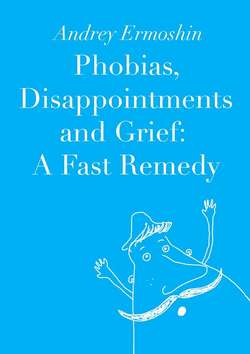Читать книгу Phobias, Disappointments and Grief: A Fast Remedy - Андрей Ермошин - Страница 6
Part 1. Work through Phobias and Panic Attacks
1.2. What is a phobia: general remarks
Sad statistics
ОглавлениеAccording to population studies, the majority of healthy individuals (60.7% of men and 51.2% of women) at some moment of their lives get serious psychological traumas accompanied by fear, desolation, or a feeling of helplessness.
On average, in a quarter of all cases the traumas take root and become chronic. (See.: В. Н. Краснов с соавт., 2007).
I’ve tried to find out how many people feel uncomfortable in their everyday life because of their fears.
The situation according to a survey taken on my site Psychocatalysis.ru, in 2011—2012, is the following:
– 59.2% of the surveyed admitted “feeling uncomfortable about certain aspects of reality”,
– 33.8% of people declared “having a certain phobia”.
The option “I’m not afraid of anything” was chosen by just 7%.
The most frequent fears of the modern metropolitan population are connected with health, traffic, and means of transportation. In addition to this short list, there is a long list of more exotic and rare fears.
For example, one can develop the fear of feathers after hearing the news about the bird flu.
It’s worth saying that mankind has experienced phobias since the dawn of time.
In the works by Areteus of Cappadocea (latter half 1st century B.C.) there’s a description of a case in which you can easily recognize what today would be called agoraphobia.
“Some patients don’t show anything unusual at home, but in less familiar atmosphere, you can notice at once the incapacity of their mind. One carpenter was like this. He measured the planks carefully, was a skilled woodworker, made reasonable arrangements with the customers, but all this was only when he was within his usual scope of activity. But every time he was going to the square, to the market or baths he put down his tools with a deep sigh, bent his back, started to shake and went into a state of sad agitation as he was losing sight of his workshop and his apprentices. After he turned back home, he calmed down and went about work again.”
(Каннабих Ю. 1994. p. 45).
Felix Platter (1537—1614) describes obsessive-compulsive disorders amongst other mental diseases:
“One woman, a correspondence clerk’s wife, can’t dismiss a fear of killing her husband, whom she loves very much by the way. Another woman, a cantiniere, feels the same kind of worry concerning her newborn baby; both of them would like to forget about these thoughts, but they can’t”
(Ibid., p. 93—94).
The number of phobias is almost immeasurable. There are people who try to classify fears and add new exotic names to the list… This list called the doctrine of fears, was named by one specialist as “the garden of Greek roots” (You can see it at Appendix I). In my opinion, such classification is more philological than bearing any practical value. The keys to working through these unpleasant states is the knowledge about the processes which go on in the mind when a person is afraid, rather than the terms used to name various conditions.
